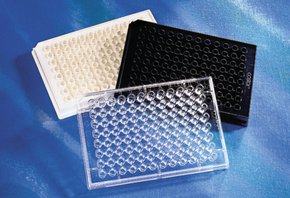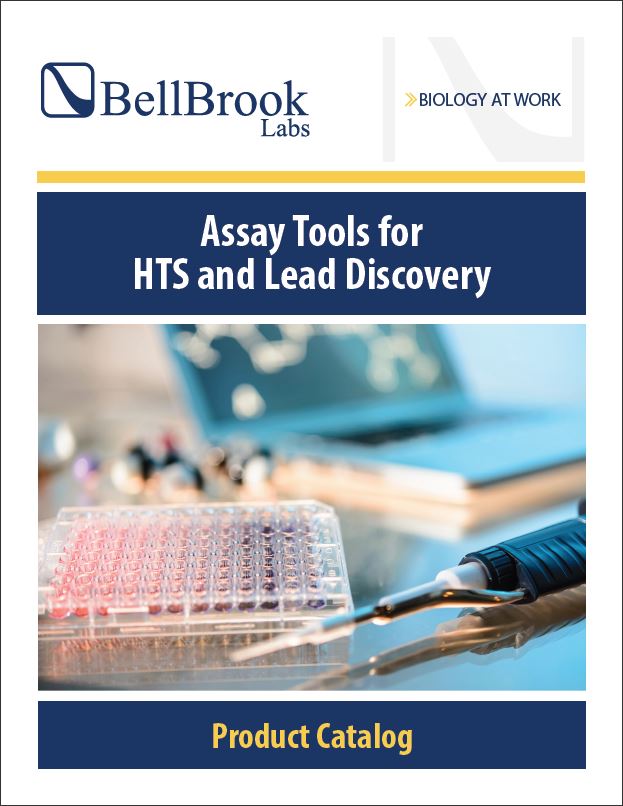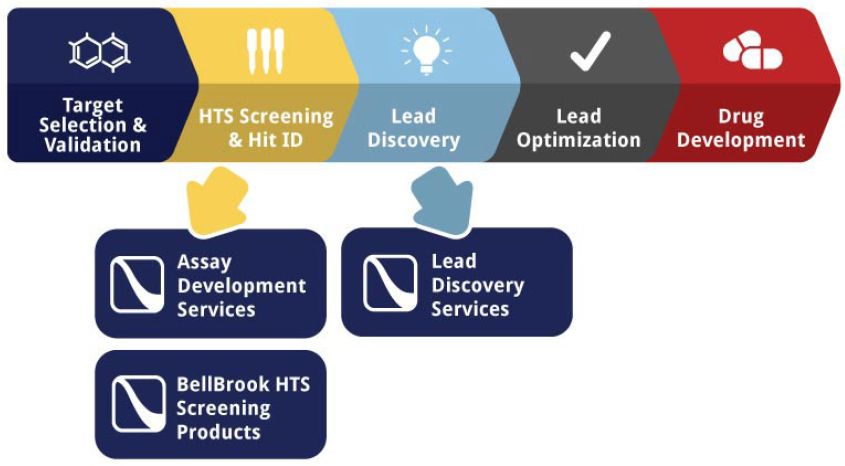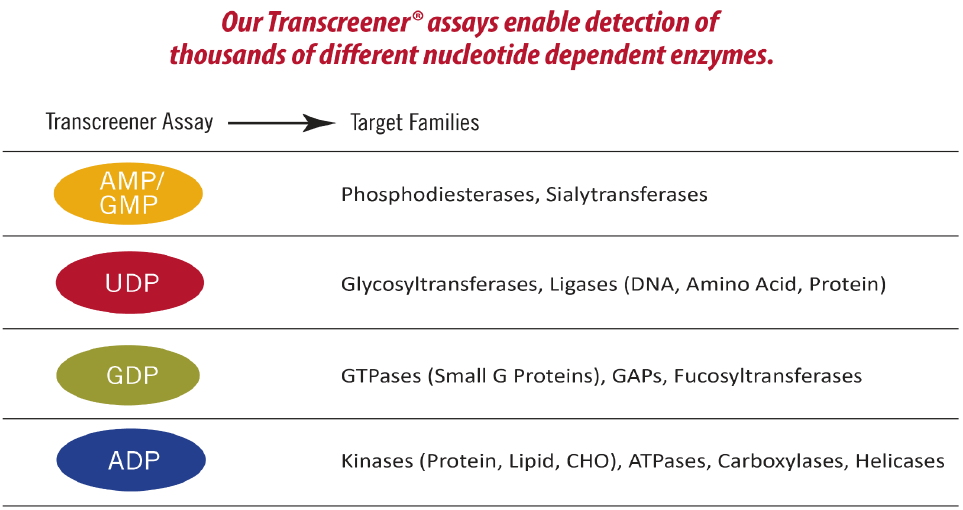Cookie Policy: This site uses cookies to improve your experience. You can find out more about our use of cookies in our Privacy Policy. By continuing to browse this site you agree to our use of cookies.
BellBrook Labs Drug Discovery - Transcreener High-Throughput Screening Assays
BellBrook Labs, a US-based company, is dedicated to accelerating drug discovery and biological research. The company’s Transcreener® HTS enzyme assays, used by all of the major pharmaceutical companies, make it easy to screen thousands of different enzymes, including validated targets like kinases, as well as emerging targets like ATPases, GTPases, methyltransferases, cGAS, Helicases, and glycosyltransferases. Assay development and lead discovery services help customers advance targets through drug discovery programs with confidence.
BellBrook Labs Transcreener® and AptaFluor Assay Kits are robust, repeatable, easy-to-use enzyme activity assays for drug discovery. By directly detecting the common product of an enzymatic reaction, e.g. ADP for kinases, Transcreener provides a universal method that can be used across an entire target family. Direct detection and far-red fluorescent readouts (by fluorescence polarization, fluorescence intensity or TR-FRET) limit interference, producing accurate results that accelerate your drug discovery.
AdipoGen Life Sciences provides the complete BellBrook Labs product range in Switzerland and Italy. For comprehensive information on the available Assays, please also check https://bellbrooklabs.com/.
For a product overview please see below:
- Transcreener® & AptaFluor Assay Technology
- NEW & UNIQUE Transcreener® cGAMP cGAS Assay
- Transcreener® and Aptafluor Assays Overview
- Enzolution™ - Validated Assay Overview
- Validated Active Enzymes
- Corning Plates for Transcreener Assays
- Marketing Flyers and Application Videos
For Product Inquiries: info@adipogen.com
Transcreener® Assay Technology: How does it work?

Transcreener® assays detect highly specific nucleotides using antibodies that can differentiate between nucleotides based on a single phosphate group. Selectivities for the product nucleotides vs. the substrates (e.g., ADP vs. ATP for a kinase assay) range from 150-fold to over 1000-fold. This exquisite selectivity allows detection of nucleotide enzyme products in the presence of an excess of the substrate nucleotide (e.g, ADP detection in the presence of excess ATP for kinase assays), a requirement for measuring enzyme initial velocity.
To generate a signal, the Transcreener® assays use a homogenous, competitive immunoassay format in which the antibodies are paired with high-affinity fluorescent tracers. Displacement of the tracer by the nucleotide being detected causes a change in its fluorescence properties. Transcreener provides a choice of three fluorescent readouts; FP, TR-FRET, and FI.
Transcreener® assays have fewer reagents and a less complex mechanism than any other nucleotide detection assay, which generally require coupling enzymes to convert a nucleotide to a product that can generate a signal with a reporter enzyme. Each coupling and reporter enzyme is a potential target for the compounds being screened, which increases the risk of false positives or of missing a hit, and requires additional wells for counter-screening.
Direct detection also means that the protocol is the simplest and most flexible available. They are validated on all major multimode readers with well-defined filters and settings (for Instrument Compatibility Table) and can be used with 96, 384, or 1536 well formats.
Thousands of cellular reactions use nucleotides, including most of the enzymes that catalyze posttranslational modifications of proteins such as phosphorylation and methylation. Because of their central role in signal transduction, many PTM enzymes have become drug targets. Though protein kinases get the most attention, acetyltransferases, methyltransferases, and glycosyltransferases are also clinically validated targets and many more PTM-related drugs are in the pipeline. Transcreener® assays were developed to enable HTS efforts targeting PTM enzymes, as well as other types of nucleotide-dependent enzymes, including ATPases, GTPases, and phosphodiesterase (for Application Notes).
Comparison between the Transcreener ADP2 Assay from Bellbrook Laboratories and the ADP-Glo Assay from Promega, show multiple advantages of the Transcreener assay (for Comparison Slides).
AptaFluor – Leveraging the Power of Aptamers for Drug Discovery

Epigenetic regulation has been shown to be a contributing factor in a variety of diseases. The discovery of methyltransferase inhibitors is currently an area of intense activity. Methyltransferase enzymes methylate a variety of substrates using S-adenosylmethionine (SAM) as the methyl donor leaving the common product S-adenosylhomocysteine (SAH).
The AptaFluor SAH Methyltransferase Assay uses a naturally occurring aptamer, or riboswitch, that selectively binds with SAH, the invariant product of methyltransferase reactions. The exquisite affinity and selectivity of the riboswitch combined with a positive TR-FRET signal enable screening and profiling of methyltransferases with unparalleled sensitivity.
By directly detecting SAH in a homogenous format, it is possible to perform screening and enzymatic studies with virtually any methyltransferase. The assay can be used as a tool to aid researchers in hit identification and characterization in a quest to develop new methyltransferase inhibitors as treatments for disease.
Key Attributes/Advantages:
• Direct Detection of SAH with a TR-FRET Readout
• Ultra-Sensitive
• Use with Physiological SAM Concentrations Lower than 100nM
• Outstanding Reagent and Signal Stability
• Excellent Z’ under a variety of assay conditions
• Simple Mix-and-Read
• Universal Assay – Use with Virtually Any Methyltransferase
Transcreener® and AptaFluor Assay Kits can be used for:
- Screen for small molecule inhibitors
- Determine enzymatic activity
- Profile inhibitor potency / determine IC50 values
- Measure residence time / off-rate / dissociation of lead molecules with target
- Inhibitor selectivity profiling
- Mechanism of action studies
Important Advantages to other Assays are:
- Universal – Use with virtually any kinase
- Direct detection of nucleotide enzyme products eliminates complex coupling steps that add to assay interference
- The sensitivity of Transcreener enables accurate data, generating Z’ values of greater than 0.7 at substrate conversion levels less than 10%
- Saves you time and development costs by using a single set of reagents for the entire kinase enzyme family
- Your choice of FP, FI, and TR-FRET readouts with certified performance on major multimode readers
- Overnight reagent and signal stability means you get reliable, robust screening data in large automated screens
- Safe, non-radioactive assay method
- Measure enzyme activity in real-time allowing for residence time determination in an HTS format.
For Detailed information please see the Transcreener® HTS Assay Overview Page and download BellBrook Labs Guide to "Measuring Drug-Target Residence Times with Biochemical Assay"
NEW & UNIQUE Transcreener® cGAMP cGAS Assay

The Transcreener® cGAMP cGAS FP Assay (Prod. No. BBL-3024) is a far-red, competitive fluorescence polarization (FP) assay. Because the antibody is highly selective for cGAMP, the assay can be used to measure activity of the cyclic GMP-AMP synthase (cGAS) enzyme which converts ATP and GTP, to cGAMP. cGAS is a recently discovered enzyme that acts as a foreign DNA sensor that induces an immune response via activation of the stimulator of interferon genes (STING) receptor. By directly measuring cGAMP with a highly selective antibody, it is possible to assay the activity of cGAS while screening large compound libraries for inhibitors. This assay can be used to i) measure enzymatic activity of cGAS, ii) screen compound libraries for cGAS inhibitors, iii) quantify inhibitor potency or iv) determine inhibitor-cGAS residence time.
| Product Name | PID | Detection |
| Transcreener® cGAMP cGAS FP Assay | BBL-3024 | Fluorescent Polarization |
| Transcreener® cGAMP cGAS TR-FRET Assay | BBL-3025 | TR-FRET |
| NEW cGAS (human) (rec.) (His) (Active) |
BBL-2227 BBL-2228 |
Active Enzyme |
Transcreener® and Aptafluor Assays Overview
Transcreener® is the simplest, most robust HTS platform available for nucleotide-dependent enzymes. These are Mix-and-Read assays for Kinases, ATPases, GTPases, methyltransferases, phosphodiesterases, glycosyltransferases, DDR enzymes and immune sensors with first-in-class sensitivity and performance.
- The only HTS method for direct detection of nucleotides produced by enzymes
- Detects thousands of enzymes: kinases, ATPases. GTPases, phosphodiesterases, glycosyltransferases, exonucleases, etc.
- Continuous OR end point assays
- True single-step mix-and-read format
AptaFluor is the simplest, most sensitive methyltransferase assay available.
- Mix-and-read SAH detection
- Detect any methyltransferase using SAM at Km concentration
- Use with virtually any methyltransferase enzyme
Enzolution™ - Validated Assay Overview
Enzolution™ is a complete assay solution. Here is how it works. You take a Transcreener Assay and an Enzolution™ Assay System (sold separately), and together you have everything you need perform inhibitor screening and dose-response measurements for a given target. This includes assay plates, substrates, enzymes, and assay buffers. Enzymes are also available individually!
- Validated enzymes, substrates, buffers, and protocols, ready for inhibitor discovery
- Designed to be used with the Transcreener and AptaFluor platforms
- Enzolution™ is the one-stop-shop for your biochemical assay needs
Validated Active Enzymes
Highly active human enzymes validated for HTS in Bellbrook Laboratories proprietary assays: cGAS, TREX1, PolQ, WRN, PARG, CD38, DDX helicases, MDA5, RIG-I, and many more.
Corning Plates for Transcreener Assays - Choose the Right Plate for your Assay

Transcreener® HTS Assays rely on direct immunodetection of nucleotides with a far-red readout in a simple mix-and-read format. The assays are available in three different detection modes, fluorescence polarization (FP), fluorescence intensity (FI), and time-resolved Forster resonance energy transfer (TR-FRET). A good microplate reader and the right choice of plates to differentiate specific signals versus background signals or “noise” is crucial to the success of these assays.
To achieve the best results be sure to:
- Use polystyrene, non-binding plates
- Make sure the plate has the correct working volume
- Use black plates for FP & FI
- Use white plates for TR-FRET
|
More Information
|
Downloadable Flyer
|
|
|
BellBrook Labs Catalog 2024 |
 Download |
|
|
BellBrook Labs Services 2024 |
 Download |
|
|
Transcreener® cGAMP cGAS Assay Flyer |
Download |
|
|
Guide to Hit Prioritization |
 Download |
|
|
|
||
|
|
Information Videos | |
|
|
BellBrook Labs Offers Complete Biochemical Assay Solutions for Your Toughest Enzyme Targets. Whether you are screening a million compounds, prioritizing hits from a virtual screen, or optimizing a lead molecule, our enzyme activity assay solutions will generate the high-quality data you need to advance your program. Learn more about what we do to accelerate discovery. |
|
|
|
Sensitivity is critical to HTS assay development. The two biggest reasons include using less enzyme and allowing for flexible assay conditions. Using less enzyme saves the user a lot of money when screening. Transcreener assays are up to ten times more sensitive than competitor assays. Learn more about why assay sensitivity is critical to your HTS campaign. |
|
|
|
Transcreener is an HTS assay platform for measuring enzyme activity. In this video, we use kinase activity assays as an example. A kinase uses ATP as a phosphate donor, leaving ADP as a product. By measuring a common product of enzyme reactions such as ADP, the assay is universal, meaning it can be used to measure the activity of any enzyme that produces that product. Learn more about how Transcreener works, including its three fluorescent readouts. |
|
|
|
Unlock the potential of drug discovery with the right enzyme activity assay! Transcreener stands out with its ultra-sensitivity and simplicity. Experience robust and accurate results that are easily scalable for high-throughput screening (HTS). Plus, its flexibility allows for kinetic mode operation, making assay development and SAR studies effortless. |
|
|
|
When time and budget matter, BellBrook’s Enzolution™ Assay Systems give you a head start. Designed for drug discovery teams focused on critical enzyme families, these pre-optimized kits combine high-quality reagents and detailed protocols, so you can focus on results, not assay development. |
|
|
|
Virtual screening, whether ligand-based or structure-based, is a powerful approach in small-molecule drug discovery. But identifying a hit is just the beginning. To move beyond predictions, you need biochemical validation. In this video, we walk through the critical steps for confirming virtual screening hits. |
|
|
|
In this video, BellBrook Labs introduces the AptaFluor® SAH Assay: a next-generation solution for detecting methyltransferase activity with unmatched sensitivity and specificity. Leveraging the natural selectivity of RNA aptamers, our team developed a TR-FRET-based, homogeneous assay capable of detecting low nanomolar SAH in the presence of excess SAM, meeting the stringent requirements of even the slowest MT enzymes. |
|
|
|
Discover the Heliscreener RNA Unwinding Assay, a high-throughput, fluorescence-based assay for DEAD-box helicases. Ideal for drug discovery, inhibitor screening, and RNA metabolism research. |




